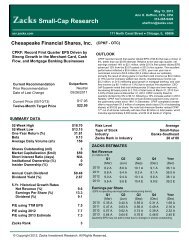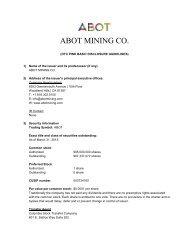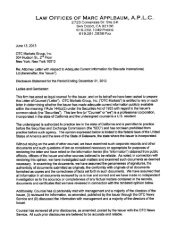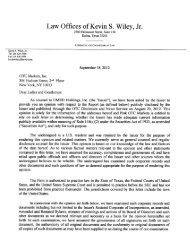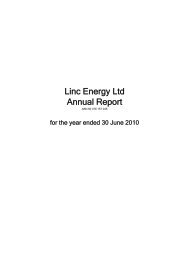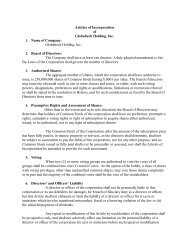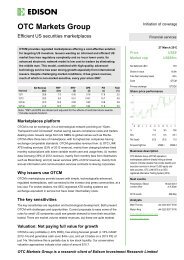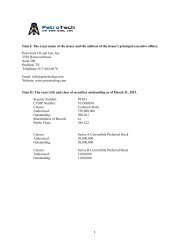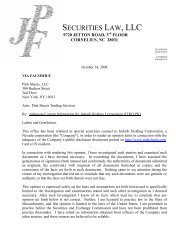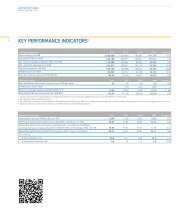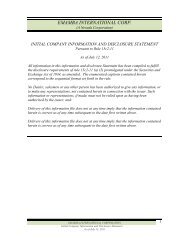2013 Apr 15 Annual Report 2012 - Phosphagenics
2013 Apr 15 Annual Report 2012 - Phosphagenics
2013 Apr 15 Annual Report 2012 - Phosphagenics
Create successful ePaper yourself
Turn your PDF publications into a flip-book with our unique Google optimized e-Paper software.
Notes to the consolidated fi nancial statements<br />
2. SUMMARY OF SIGNIFICANT ACCOUNTING POLICIES (CONTINUED)<br />
(e) Significant accounting judgements, estimates and assumptions (continued)<br />
Development costs<br />
An intangible asset arising from development expenditure on an internal project is recognised only when<br />
<strong>Phosphagenics</strong> can demonstrate the technical feasibility of completing the intangible asset so that it will<br />
be available for use or sale, its intention to complete and its ability to use or sell the asset, how the asset<br />
will generate future economic benefi ts, the availability of resources to complete the development and<br />
the ability to measure reliably the expenditure attributable to the intangible asset during its development.<br />
Any expenditure capitalised is amortised over the period of expected future benefi t from the related project<br />
on a straight line basis. The carrying value of capitalised developments costs not yet available for use<br />
is tested for impairment annually at 31 December.<br />
Certain development costs relate to patents which have fi nite lives. These costs are being amortised over<br />
their remaining useful lives which ranges between 9 to 12 years.<br />
(f) Cash and cash equivalents<br />
Cash and short term deposits in the statement of fi nancial position comprise cash at bank and in hand<br />
and short-term deposits with an original maturity of six months or less, that are readily convertible<br />
to known amounts of cash and which are subject to an insignifi cant rate of change in value.<br />
For the purposes of the consolidated statement of cash fl ows, cash and cash equivalents consist of cash<br />
and cash equivalents as defi ned above, net of outstanding bank overdrafts.<br />
(g) Provisions and employee benefits<br />
General<br />
79<br />
Provisions are recognised when the Group has a present obligation (legal or constructive) as a result<br />
of a past event, it is probable that an outfl ow of resources embodying economic benefi ts will be required<br />
to settle the obligation and a reliable estimate can be made of the amount of the obligation.<br />
When the Group expects some or all of a provision to be reimbursed, for example under an insurance<br />
contract, the reimbursement is recognised as a separate asset but only when the reimbursement is<br />
virtually certain. The expense relating to any provision is presented in the statement of comprehensive<br />
income net of any reimbursement.<br />
Provisions are measured at the present value of management’s best estimate of the expenditure required<br />
to settle the present obligation at the reporting date. The discount rate used to determine the present<br />
value refl ects the current market assessments of the time value of money and the risks specifi c to the<br />
liability. The increase in the provision resulting from the passage of time is recognised in fi nance costs.<br />
Employee leave benefits<br />
Wages, salaries and, annual leave.<br />
Liabilities for wages and salaries, including non-monetary benefi ts and annual leave expected to be settled<br />
within twelve months of the reporting date are recognised in respect of employees’ services up to the<br />
reporting date. They are measured at the amounts expected to be paid when the liabilities are settled.<br />
Liabilities for non-accumulating sick leave are recognised when the leave is taken and are measured<br />
at the rates paid or payable.<br />
Long service leave<br />
The liability for long service leave is recognised and measured as the present value of expected future<br />
payments to be made in respect of services provided by employees up to the reporting date using the<br />
projected unit credit method. Consideration is given to expected future wage and salary levels, experience<br />
of employee departures, and periods of service. Expected future payments are discounted using market<br />
yields at the reporting date on national government bonds with terms to maturity and currencies that<br />
match, as closely as possible, the estimated future cash outfl ows.<br />
NOTES TO THE CONSOLIDATED FINANCIAL STATEMENTS



